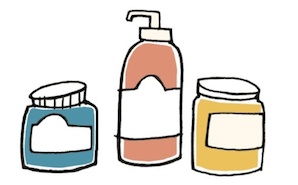Are the long hours, stressful conditions and harsh sanitizing agents in the average hospital workplace taking a toll on your skin? Nurses often struggle with looking their best in the face of a work environment that does little to support healthy, glowing skin. You have to take extra steps to pamper yourself if you want to look fabulous! Here are 20 easy tips that nurses can use throughout the day to maintain beautiful skin.
Reevaluate Your Hand Hygiene
Hand washing and glove use are the cornerstones of infection prevention in healthcare settings. But these protocols are the leading cause of contact dermatitis in nurses. If you are experiencing an allergic reaction or chemical sensitivity, take a closer look at what you’re being exposed to.
AT WORK
- Switching to non-latex gloves or using a hand sanitizer that doesn’t dry your skin as much may help.
- Only wear gloves when they are needed and take them off to let your hands “breathe” the rest of the time.
AT HOME
- Minimize the detergents and surfactants you use at home to further limit your exposure to chemicals that will dry your skin.
Moisturize, Then Moisturize Again
Constant hand washing and the use of alcohol-based hand sanitizers will dry out your skin even if you don’t end up with a rash. When your skin dries and cracks, it isn’t as resistant to infection. Nothing is uglier than a staph infection!
AT WORK
- Use hand moisturizer throughout the day each time you wash your hands to help restore your skin.
- Consider using an SPF 15 moisturizer so you’ll be in the habit of keeping sunscreen on your hands. That will help you prevent sun damage to delicate hand skin when you venture outside. Remember, no matter how good your face looks, people can always guess your age by your hands!
AT HOME
- Apply Vaseline or a heavy-duty moisturizer at night (just don’t mix petroleum-based creams with latex gloves at work).
- Pay special attention to ragged cuticles—pushing them back gently each day rather than trimming them. Use a cuticle oil a couple of times a day to soften this skin and make it more pliable.
Keep on Moving
Few of us reach our 40s without seeing the telltale marks of time etched into our leg skin. Spider veins are mainly a cosmetic problem (although they may indicate varicose veins below the surface). One of the main activities associated with the development of spider veins is standing for long periods of time. If you’re a nurse, you may find it difficult to avoid being on your feet for hours on end. However, you may be able to limit the development of spider veins by:
AT WORK
- Frequently shifting your weight from one foot to the other when you are standing
- Elevating your feet when you do get a chance to sit down
- Keeping your body weight under control by not skipping meals and try ‘smart snacking’ between meals on high energy foods such as fruits, veggies and nuts
- Wear compression stockings if you have a family history of vein problems
AT HOME
- Already got a few veins creeping across your calves? Don’t reconcile yourself to never showing your gams in public again. Use a light-coverage concealer like Sally Hansen’s Airbrush Legs to minimize the appearance of spider veins. Unlike self-tanning lotions, this product washes right off if you make a mistake.
Put Your Best Foot Forward
Few of us consider our feet our most attractive feature, but that’s no reason to neglect them! The skin on your feet is especially prone to fungal infection if you’re up and about all day in shoes that hold sweat close to your skin.
AT WORK
- Wear nursing shoes and socks that are breathable.
- If you wear leather shoes, buy two pairs and alternate them each day. This gives the leather time to dry out fully after each shift.
- Consider wearing athletic shoes that meet your hospital’s dress code since these often have mesh panels that allow better air penetration.
AT HOME
- Go barefoot in the safety of your own home to give your feet a chance to air out.
- Do you like to treat yourself to a pedicure or paint your toenails? It’s a good idea to give your toenails a break from the lacquer if you want to avoid the dreaded toenail fungus. Get your toenails done before an event where people will actually see them (vacation, a party where you’ll be wearing open-toed shoes, etc.). Then strip off the polish afterward to keep fungus from gaining a “foothold.”
Keep Your Face Looking Fresh
Okay, we’ve covered your body from hand to toe, but what about your face? Here are three beauty secrets for looking your best with minimum effort:
AT HOME
- Exfoliate with care. Many facial scrubs contain gritty fragments that can cause micro-tears in your skin. That makes your skin look rougher instead of smoother over the long term. Consider using AHA cleansers or other products that let you gently wipe away dead skin rather than scrubbing it off.
- Keep under-eye bags at bay with cool compresses. These are easy to use and cost you nothing. Try this remedy before you invest in expensive creams to address your saggy under-eye area.
- Use a bronzer to give a sun-kissed glow to skin that rarely sees the sun. Apply it lightly to any areas that would naturally get the most sun exposure (forehead, cheekbones, nose, chin and collarbone). Pick a bronzer no more than two shades darker than your natural skin tone so you don’t look like an Oompa-Loompa.
What skin beauty tips do you use to stay looking great at work? Let us know in the comments.


















